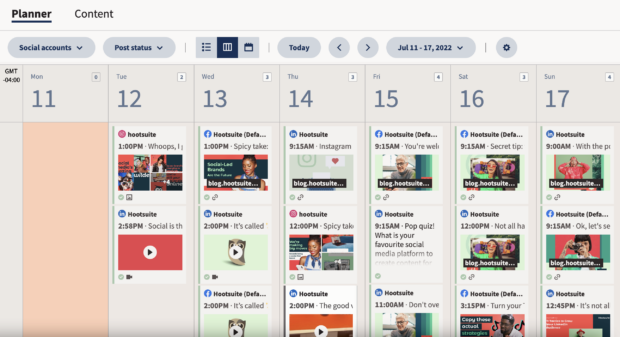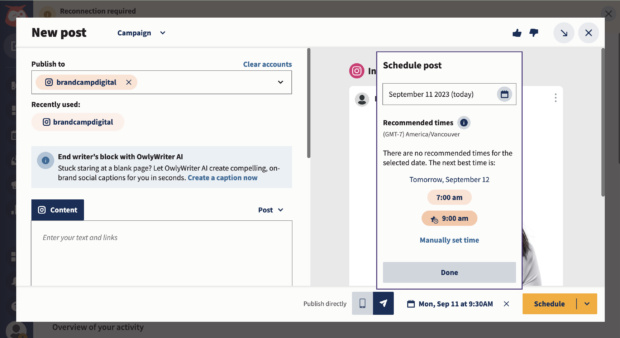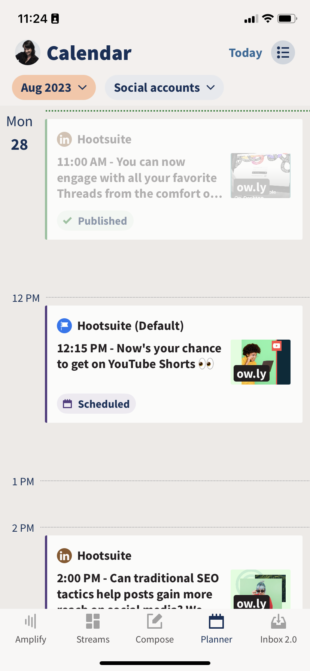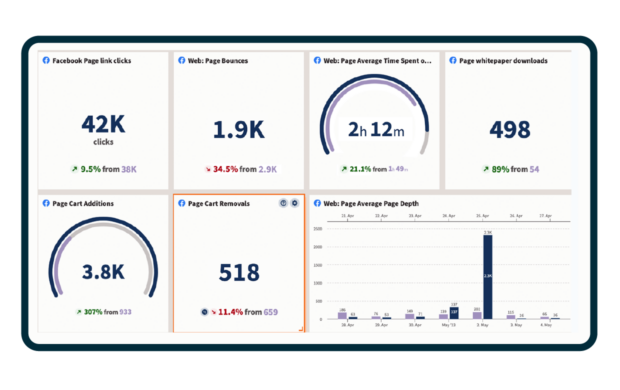Short on time? Get this down-to-the-minute guide that will show you how to manage social media in as little as 18 minutes per day.
Wondering how to manage social media for your business when you don’t have the bandwidth or budget?
Many small business owners struggle to balance social media with other responsibilities. Payroll, product development, and customer service often take precedence over managing multiple social media accounts.
Yet, research shows that more than 40% of digital shoppers research new brands and products using social media. Without an active presence, customers may choose to shop elsewhere.
For those who are short on time, we’ve put together an 18-minute plan for managing social media for a business. This plan takes you minute-by-minute through the social necessities, highlighting time-saving tips along the way.
How to manage social media in 18 minutes a day
Here’s a down-to-the-minute look at how to manage business social media accounts.
Minute 1-3: Listen in
Your first three minutes should be devoted to tapping into your social media audience. Who are they? Where do they hang out? What topics do they care about?
This process is called social listening, and it involves monitoring conversations online about your brand, your competitors, and topics related to your industry.
Here are a few things you should check and take note of each day:
- Mentions of your brand
- Mentions of your product or service
- Specific hashtags and/or keywords
- Competitors and partners
- Industry news and trends
As well, if your business has a physical location or storefront, use geo-search to filter for local conversations. That will help you focus on customers close to you and the local topics they care about.
So, how do you go about collecting this data?
There are a few ways to hatch a social listening plan. First, you can set up Google Alerts for keywords related to your business. You can also manually search the internet for mentions of your brand. But that might take a while.

If you want to take this even further, you can tap into a super-powered social listening tool like Talkwalker.

Source: Talkwalker
Social media pros use Talkwalker to analyze engagement, reach, comments, brand sentiment, important influencers, conversation clusters, and much more.

Minute 3-8: Analyze your findings
Your next five minutes of managing business social media accounts involves analyzing your findings. Doing this will help you fine-tune your social listening process and marketing efforts.
Here are some of the details you should keep in mind:
1. Sentiment
Sentiment analysis rests on a few key questions: How are people talking about your brand? How does it compare with how they are talking about your competitors? If things are mostly positive, that’s great. If negative, start thinking about ways to steer the conversation more positively.
2. Feedback
Do your customers have specific feedback about your business? Look for recurring trends and insights that you can act on.
For example, if you run a restaurant and you often get feedback that the music is too loud, turn it down. If you offer a product, such as gym bands, and customers are interested in more color options, you’ve just spotted a new sales opportunity.
3. Trends
What are the current trends in your industry? Uncovering them can help you identify new niches and audiences to engage with. Or, maybe they’ll inspire content for your next marketing campaign. Even better—maybe they’ll inform the development of a new product or service.
4. Purchase intent
Learning how to manage social media doesn’t only involve tracking conversations from current customers. It can help you find new customers, too.
Track phrases or topics prospective customers may use when they’re in the market for your offering.
For example, if your company is a travel provider, you may want to track keywords like “winter blues” and “vacation.”
Reply to people who are looking for items or services you sell.
5. Updates
Have you noticed a new keyword mentioned again and again online? Or maybe you keep seeing a common typo when people mention your brand. Keep an eye out for things you should add to your social media listening tracking list. Your customers are your greatest source of information.

Minutes 8-10: Check your content calendar
Next, check your content calendar to see what you’ve planned to post for the day. Double-check that visuals, photos, and copy are all good to go. Always make sure to proofread one last time to spot those last-minute typos.

Hopefully, you already have a social media marketing plan and content calendar in place. If you don’t, plan to set aside about an hour each month to brainstorm, prepare ideas, and fill in your calendar.
Whether you outsource content creation, take advantage of free tools, or do everything yourself, having a solid social marketing strategy makes social media management much easier.
If you don’t have time or budget for high-production content, consider adding user-generated content, memes, or curated content to your social media calendar.

Now, it’s time to share the content you’ve created. What you post on social media should depend on the type of business you have and your audience’s interests.
Connect with customers by sharing articles, videos, and photos about your products or services. Use popular social media features such as Instagram stories, Facebook polls, and Twitter Live to engage and interact with followers.


Tip: Use analytics to see when your audience is usually online, too. It may be different from the global average.
Minute 15-18: Engage with your audience
Once your posts are perfect and ready to launch, it’s time to get active and engage with your audience. Start by responding to questions or comments about your brand, products, or services. And don’t forget to thank people for sharing feedback or making purchases.

The best way to engage with your audience is by offering them something of value. Share information or resources that they can use in their day-to-day lives. That might be a blog post about the top holiday gifts for pet parents or tips on grilling the perfect steak.

You should also ask questions to keep the conversation going:
- “What do you think of our latest product launch?”
- “What type of content would you like to see from us?”
- “What can we do to make your experience better?”
To save time, you can create templates for common responses. These are particularly useful when you find yourself frequently sharing the same specific details, like opening hours or return policies.
But don’t overuse boilerplate responses. People appreciate authenticity and want to feel like a real person is engaging with them. Even something as simple as leaving customer service agent initials in replies increases goodwill from consumers.
Tip: When possible, try to engage shortly after posting something. If you’ve timed it right, that’s when your audience will be online and engaging. That way, you’ll interact with people in real time and maintain a good response time, too.
Looking for more time-saving social media tools? These 9 social media templates will save you hours of work.
18-minute social media plan template
Still stuck on how to run social media accounts? Use this template to create your own 18-minute social media plan.
Other social media management time-saving tips
The best way to manage social media for a company is to stay organized and plan ahead. Here are a few tips to streamline your process:
Automate scheduling

Keep everything in one place
Organize your content, notes, images, and other materials in a central spot. Create categories or labels so you know where to find specific things later on. Storing everything in one place will save you time when creating new posts or referring back to content.
Leverage reporting tools
Reporting is key to understanding how your social media efforts are paying off. Use analytics and reporting tools to see what’s working and where to improve. This will help guide your strategy going forward so you can focus on the activities that increase engagement or sales.

Monitor mentions and conversations
It’s essential to respond quickly and appropriately when people mention your brand online. Set up social listening tools to alert you when someone mentions your business or products so you can thank them and answer any questions they have.
Delegate tasks to a team
Divide and conquer, if you can. Assign different social media activities to team members. Have one team member create content, another schedule posts, and a third respond to customer service inquiries. This way, you’ll be able to get everything done efficiently while still being responsive.
Learn more about social media workflows here.

Stay up-to-date with trends
Social media moves quickly! Keep up with the latest trends by following industry thought leaders and joining relevant conversations. That way, your business will stay relevant and engaged with the latest updates in your industry.
